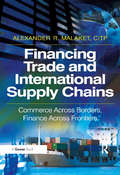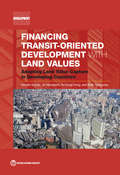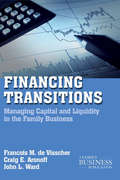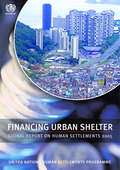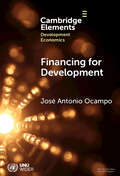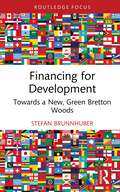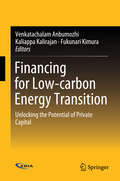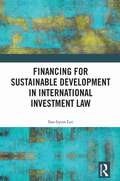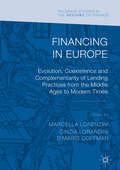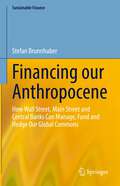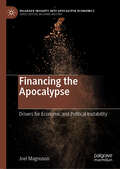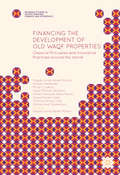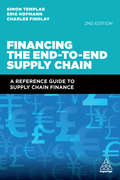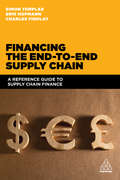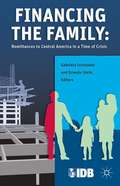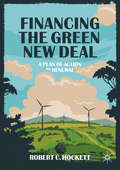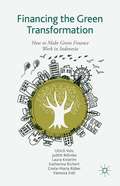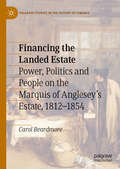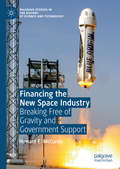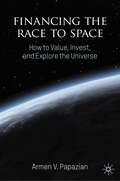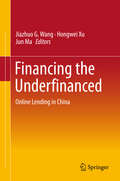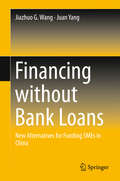- Table View
- List View
Financing Trade and International Supply Chains: Commerce Across Borders, Finance Across Frontiers
by Alexander R. MalaketThe vast majority of international trade is supported by some form of trade financing: a specialized, sometimes complex form of financing that is poorly understood even by bankers and seasoned finance and treasury experts. Financing Trade and International Supply Chains takes the mystery out of trade and supply chain finance, providing a practical, straightforward overview of a discipline that is fundamental to the successful conduct of trade: trade that contributes to the creation of economic value, poverty reduction and international development, while increasing prosperity across the globe. The book suggests that every trade or supply chain finance solution, no matter how elaborate, addresses some combination of four elements: facilitation of secure and timely payment, effective mitigation of risk, provision of financing and liquidity, and facilitation of transactional and financial information flow. The book includes observations on the effective use of traditional mechanisms such as Documentary Letters of Credit, as well as an overview of emerging supply chain finance solutions and programs, critical to the financing of strategic suppliers and other members of complex supply chain ecosystems. The important role of export credit agencies and international financial institutions is explored, and innovations such as the Bank Payment Obligation are addressed in detail. Financing Trade and International Supply Chains is a valuable resource for practitioners, business executives, entrepreneurs and others involved in international commerce and trade. This book balances concept with practical insight, and can help protect the financial interests of companies pursuing opportunity in international markets.
Financing Transit-Oriented Development with Land Values
by Hiroaki Suzuki Beth Tamayose Jin Murakami Yu-Hung HongCities in developing countries are experiencing unprecedented urban growth. Unfortunately, this is often accompanied by the negative impacts of sprawl as a result of rapid motorization such as congestion, air pollution, greenhouse gas emissions, inefficient use of energy and time, and unequal accessibility. As these cities are often under severe fiscal constraints, they face great challenges in financing capital-intensive mass transit systems to reverse the course of these negative trends. Development-based land value capture (DBLVC) financing schemes being practiced in Asian megacities like Hong Kong SAR, China, and Tokyo have helped them not only to generate funds for transit investment and operational and maintenance costs but also to promote sustainable urban development through transit-oriented development (TOD). Many rapidly growing cities in developing countries have the conditions for introducing DBLVC " namely, strong economic growth, rising real incomes and increased motorization and congestion levels " all of which cause land value appreciation within proximity of transit stations or corridors. If adapted well to local contexts, DBLVC schemes have great potential to become an important strategic apparatus of urban finance and planning for cities in developing countries. Through a careful analysis of various case studies, this book provides strategies, policies, and methodologies that policy makers and practitioners can apply in developing their own DBLVC schemes for transit financing.
Financing Transitions: Managing Capital and Liquidity in the Family Business (A Family Business Publication)
by John L. Ward François M. de Visscher Craig AronoffThis book establishes the principles and patterns necessary to laying the foundation for capital and liquidity planning. Through an in-depth examination of financial situations, it leads family businesses to making wise, well-timed choices about the future of the business and the family.
Financing Urban Shelter: Global Report on Human Settlements 2005
by Un-Habitat'Achieving the goals set by world leaders in the United Nations Millennium Declaration will be difficult without a significant improvement in the lives of slum dwellers, and the lives of slum dwellers cannot be improved without the sound and sustainable economic development that is conducive to the establishment of a strong shelter sector. As Financing Urban Shelter: Global Report on Human Settlements 2005 emphasizes, one of the key challenges in meeting the Millennium Declaration Goal on slums is mobilization of the financial resources necessary for both slum upgrading and slum prevention by supplying new housing affordable to lower income groups on a large scale. . . . It is my hope that, by highlighting the impacts of current shelter financing systems on low-income households and by identifying the types of financing mechanisms that appear to have worked for them, this report will contribute to the efforts of the wide range of actors involved in improving the lives of slum dwellers, including governments at the central and local levels, as well as non-governmental and international organizations.' From the Foreword by KOFI ANNAN, Secretary-General, United Nations Financing Urban Shelter presents the first global assessment of housing finance systems, placing shelter and urban development challenges within the overall context of macroeconomic policies. The report describes and analyses housing finance conditions and trends in all regions of the world, including formal housing finance mechanisms, microfinance and community funding, highlighting their relevance to the upgrading of slums. Recent shelter finance policy development is discussed at the international and national levels, and the directions that could be taken to strengthen shelter finance systems are examined. The Global Report on Human Settlements is the most authoritative and up-to-date assessment of conditions and trends in the world's cities. It is an essential tool and reference for researchers, academics, public authorities and civil society organizations around the world. The preceding issues of the Global Report on Human Settlements have addressed such topics as An Urbanizing World, Cities in a Globalizing World and The Challenge of Slums. Published with UN-HABITAT
Financing for Development: The Global Agenda (Elements in Development Economics)
by José Antonio OcampoThe reform of the international financial and tax systems has been at the center of global debates in recent years –in the United Nations, the World Bank, the International Monetary Fund, the OECD and the G20. The fourth United Nations Conference on Financing for Development that will take place in Spain in 2025 also represents a great opportunity to enhance global cooperation in this area. This Element analyzes six elements of the global financing for development agenda, which are dealt with in individual sections: the role and evolution of development financing; the international monetary system; sovereign debt restructuring; international tax cooperation; international trade; and critical institutional issues. Although focusing on the international agenda, many of these issues have domestic implications for developing countries. The analysis covers both the nature of cooperation and recommendations on how to improve it. This title is also available as Open Access on Cambridge Core.
Financing for Development: Towards a New, Green Bretton Woods (Routledge Focus on Economics and Finance)
by Stefan BrunnhuberThis book provides a robust argument for an upgrade of the financial system to enable a more sustainable approach. It explores the upcoming debate on a newly modified international financial architecture, facing serial ecological crisis and the advent of new technologies, and which operates in a multipolar world.Instead of business as usual (BAU) scenarios, it explores new, innovative, out of the box approaches in the following arenas: taxonomy and regulation, including capital flow management measures and taxations schemas; financial engineering such as hedging instruments private public partnerships; and polity frameworks e.g. IMF, World Bank, Multilateral development banks, voting quota. It addresses the new role of Central Bank Digital Currencies (CBDCs), the current and upcoming campaign on debt restructuring, as well as the role of new technologies - AI and Blockchain - to tackle illicit financial transactions and fraud, including predictive coding and big DATA correlations. The book focuses on the new role of monetary regulators and central bankers in providing conditioned, additional liquidity to finance, hedge and manage our global commons and to mobilize private capital at the same time, meaning that monetary policy will oversteer fiscal and credit policy in a Bretton Woods II process. The author argues that a new green Bretton Woods 2.0 will provide the agenda to transform our economy and our society, and a Green Transition plan is included in the book.This will serve as a comprehensive reader for students, scholars and activists in the fields of macroeconomics, international development policy, finance and sustainability. It will also appeal to policy makers and executives in the financial sector as well as informed monetary experts.
Financing for Low-carbon Energy Transition: Unlocking the Potential of Private Capital
by Venkatachalam Anbumozhi Kaliappa Kalirajan Fukunari KimuraThis book is the first comprehensive assessment of the state of low-carbon investments in Asia, analyzing the rationales, mandates and public–private financing activities. Based on the experiences of several regional initiatives wherein public financing is catalyzing private investments in low-carbon infrastructure, this book proposes a framework that can be used as a tool to identify factors that influence private investment decisions and policy instruments that can scale up the private capital.Placing the Asian economies onto a low-carbon development pathway requires an unprecedented shift in investments. This book addresses this situation by asking questions such as: • What is the central role of private finance in achieving the Paris Agreement targets? • What key policy levers and risk mitigation can governments use in an effort to unlock the potentials of private capital? • How can regionally coordinated actions hold significant promise for scaling up private investments?
Financing for Sustainable Development in International Investment Law
by Soo-hyun LeeThis book highlights the intersection between international investment law and sustainable development, particularly in the context of the right to regulate for public interest related to sustainable development.Addressing key challenges hindering the harmony between investment law and sustainable development, the book unveils a new methodology to assess whether a government measure or foreign investment contributes to sustainable development. The primary question driving this text is: how should investment treaty arbitration tribunals evaluate the sustainable development impact of both government measures and foreign investments affected by those measures? Beginning by establishing a conceptual framework around the right to regulate for public interest, the book also identifies limitations in the typical approach taken in investment treaty arbitration. Additionally, broader systemic constraints within international investment law concerning sustainable development are discussed.This book will be of interest to students and scholars in the field of international investment law, economic law, and sustainable development.
Financing in Europe: Evolution, Coexistence And Complementarity Of Lending Practices From The Middle Ages To Modern Times (Palgrave Studies in the History of Finance)
by Marcella Lorenzini Cinzia Lorandini D’Maris CoffmanThis book explores the evolution of credit and financing in Europe from the Middle Ages through to Modern Times. It engages with the distinct political, economic and institutional frameworks of the examined areas (England, Italy, France, Germany, Spain, the Netherlands and Turkey) and discusses how these affected the credit market. It covers a wide range of different types of lending and borrowing instruments, the destination of capital, the way it was raised, and the impact it had on local or national economies in a very long run.Presented in two parts, part one of the book focuses on credit markets in the preindustrial age, in particular the period before the advent of modern joint stock banks. Part two examines the evolution of credit at the time of the emergence of modern banks. This volume will be of interest to academics and researchers in the field of finance who are interested in the historic evolution of credit and the credit market.
Financing our Anthropocene: How Wall Street, Main Street and Central Banks Can Manage, Fund and Hedge Our Global Commons (Sustainable Finance)
by Stefan BrunnhuberDevelopment needs to meet the UN SDG have primarily been financed through private sector financing, conventional public sector funding and philanthropic commitment. These sources are not sufficient in scale and speed to meet the pressing finance needs. The world community is too busy repairing, stabilizing, and refunding the system to maintain the stability of the existing system. The introduction of a parallel electronic currency specifically designed to finance global commons, and a human-centred economy would provide the necessary resources to achieve the UN SDGs while stabilizing the existing monetary system.This book analyses how the development of cryptocurrencies based on blockchain distributed ledger technologies has prompted leading central banks around the world to study the potential application of this approach to directly inject purchasing power without dependence on the banking system. Furthermore, the book illustrates how this approach can be utilized to finance the huge multi-trillion dollar annual investment requirements for achieving the Sustainable Development Goals (SDG).With a Foreword from the President of the Club of Rome.“This book is where fiction turns into fact.” - World Bestselling Author of ‚The Minister of the Future‘ Stan Robinson“…challenging, innovative and interdisciplinary… to address the world’s problems.” - Founder and Father of the Quantitative Easing (QE), Prof. Dr. Richard Werner, Oxford University, GB“The real tragedy of the commons, as this book shows, is that we have allowed the most valuable social resources, our money and legal systems, to be employed for private gain instead of mobilizing them for social goals, not the least to ensure the survival of the human species on this planet.” - Best-selling author of ‚The code of capital’ Katharina Pistor, Edwin B. Parker Professor of Comparative Law and Director, Center on Global Legal Transformation Columbia Law School, USA
Financing the Apocalypse: Drivers For Economic And Political Instability (Palgrave Insights Into Apocalypse Economics Ser.)
by Joel MagnusonAs we tour the 400 year history of capitalism through its various phases of development, financial system instability is always there lurking in the shadows. The historical record attests that the processes of aggregating capital for real investment are inescapably vulnerable to risk, manic speculation, unserviceable debt, and crises; and with each episode of instability, a trail of devastation follows. Economic historians such as Hyman Minsky, Charles Kindleberger and others have studied this history and have exposed certain boom-bust patterns that have a way of stubbornly repeating themselves. This book posits that the large-scale financial crises that the world has experienced over the last 30 years are more or less the latest segments in this narrative, but with some distinct characteristics. In the period spanning the stock market crash of 1987 to the banking crisis of 2008 and its aftermath – the Greenspan Era – there were key institutional and ideological developments rooted in contemporary neoliberalism that have reshaped the historic rise-and-fall patterns to become more severe and widespread. In this important volume, Magnuson suggests the next episode will be a massive financial cyclone that will send us all tumbling toward a perilous future.
Financing the Business: Where's the Money?
by Richard LueckeThis chapter describes the financing requirements that businesses typically encounter in different phases of the business life cycle, from start-up to maturity. It also provides an overview of the sources they turn to in securing financing during those phases. Two types of business--lifestyle and entrepreneurial--illustrate the general course of financing from start-up through expansion.
Financing the Development of Old Waqf Properties: Classical Principles and Innovative Practices around the World (Palgrave Studies in Islamic Banking, Finance, and Economics)
by Seyed Kazem Sadr Hisham Dafterdar Murat Cizakca Syed Othman Alhabshi Thamina Anwar Mohammed Obaidullah Magda Ismail Mohsin Shaikh Hamzah RazakThis book presents successful case studies in Muslim and Muslim minority countries that have revolutionized the redevelopment of idle waqf properties into productive land trusts. The revival of this institution over the last two decades shows the growing optimism in galvanizing the socioeconomic role of waqf by adopting its flexible shariah measures. Innovative ways of financing redevelopment allow Muslims to extend these roles to include new beneficiaries. New uses for these properties include providing services to the community, opening jobs for the majority of people, funding small entrepreneurs, educating the masses, providing health care, and sheltering the poor and needy. Countries under study include Sudan, Turkey, Malaysia, Indonesia, Singapore, New Zealand, Kuwait, Oman, Qatar, and Iran. Additionally, the book examines the International Development Bank's role in financing the development old waqf properties in different countries.
Financing the End-to-End Supply Chain: A Reference Guide to Supply Chain Finance
by Charles Findlay Erik Hofmann Simon TemplarFinancing the End-to-End Supply Chain provides readers with a comprehensive understanding of the financial synergies across the supply chain. It demonstrates the importance of the strategic relationship between the physical supply of goods and services and the associated financial flows. The book provides a clear introduction, demonstrating the importance of the strategic relationship between supply chain and financial communities within an organization. This book links together treasury, banking, supply chain, systems, IT, and key stakeholders. Financing the End-to-End Supply Chain will help senior supply chain practitioners to build collaboration, improve relationships and enhance trust between supply chain partners. With its combination of theory and practice it tackles vital issues including physical, information and financial flows, and tailoring supply chain finance to individual organisations' circumstances. Recognizing that supply chain finance means different things in different countries, the authors also consider various initiatives to harmonize and develop cross-border financing as well as including an agenda for national and international policy makers. The new edition features interviews from SCF platform providers on how ecosystems are involved in supply chain finance, additional learning activities for students and new examples on working capital management.
Financing the End-to-end Supply Chain: A Reference Guide to Supply Chain Finance
by Charles Findlay Erik Hofmann Simon TemplarFinancing the End to End Supply Chain provides readers with a real insight into the increasingly important area of supply chain finance. The book provides a clear introduction, demonstrating the importance of the strategic relationship between supply chain and financial communities within an organization. It contains vital information on how supply chain finance is operationalised and put into place. It is written in a user-friendly style, starting with the purchasing function, and linking together treasury, banking, supply chain, systems, IT, and key stakeholders. Financing the End to End Supply Chain will help senior supply chain and procurement practitioners to build collaboration, improve relationships and enhance trust between supply chain partners. With its combination of theory and practice it tackles vital issues including physical, information and financial flows, and tailoring supply chain finance to individual organisations' circumstances. Recognising that supply chain finance means different things in different countries, the authors also consider various initiatives to harmonize and develop cross-border financing from the World Bank and other institutions, as well as including an agenda for national and international policy makers.Financing the End to End Supply Chain offers a mix of academic and industrial expertise and is written by three authors who are experts in the field. The book contains ground-breaking research and data from the Cranfield School of Management.
Financing the Family: Remittances to Central America in a Time of Crisis
by Gabriela Inchauste Ernesto SteinInterest in learning how to make the most of the potential developmental benefits of remittance flows has grown worldwide. Financing the Family adds to that body of knowledge with a summary of recent research that emphasizes experimental approaches, focuses on Central America, and analyzes the impact of the recent financial crisis.
Financing the Green New Deal: A Plan of Action and Renewal
by Robert C. HockettClimate scientists have determined that we must act now to prevent an irreversible and catastrophic climatic tipping point, beyond which neither our own nor many other species can be assumed likely to survive. On the way to that bleak ending, moreover, extreme socio-economic injustice and associated political breakdown—now well underway in nations already hard-hit by environmental crisis—can be expected to hasten as well. The time has thus come to plan carefully, thoroughly, and on a scale commensurate with the crisis we face. This book, written by one of the key architects of the Green New Deal and prefaced by Representative Alexandria Ocasio-Cortez's former Chief of Staff, indicates how to structure Green New Deal finance in a manner that advances the cross-cutting goals of maximum financial and economic inclusion, maximally democratic decision-making, and an appropriate division of roles both among all levels of government and among public and private sector decision-makers. Integrating into one complete and coherent financial architecture such bold ideas as a 'People's Fed,' an interdepartmental National Investment Council, integrated state and regional public banks, a Democratic Digital Dollar and digital Taxpayer Savings and Transaction Accounts made part of the monetary policy transmission belt, and an economy-wide Price Stabilization Fund, this book is critical reading for policymakers and citizens looking for a fresh path forward towards a revived and sustainable, progressive and productive America.
Financing the Green Transformation
by Ulrich Volz Judith Böhnke Vanessa Eidt Laura Knierim Katharina Richert Greta-Maria RoeberPlanetary boundaries and a scarcity of natural resources will require a significant boost of investment into clean and renewable energy and a more efficient use of resources in developing, emerging and advanced economies alike. In this context, the financial sector will have to play a key role in providing 'green finance' for sustainable investment and development. Against this backdrop, this book investigates the challenges for developing and emerging economies in enhancing green financingfor sustainable, low-carbon investment, using Indonesia as a case study. Based on surveys in the Indonesian banking and corporate sectors and expert interviews, the book devises innovative policy recommendations for governments to develop a framework conducive to fostering green investments.
Financing the Landed Estate: Power, Politics and People on the Marquis of Anglesey’s Estate, 1812–1854 (Palgrave Studies in the History of Finance)
by Carol BeardmoreWhile there is an extensive historiography which explores English agriculture in the nineteenth century, there has been less attention paid to individual estates and in particular the role of the land agent within their management, administration and participation in rural community relationships. Nowhere is this more obvious in the lack of research into the financial history of the landed estate, even though in the early nineteenth century these were some of the largest businesses in England. The Castleman letters are a rich source which detail the intricate working, financial, social and political relationships which constituted the foundation of the landed estate. The vouchers of which more than 10,000 have survived alongside the rental accounts have rarely been examined. On their own they illustrate, for example: the sums paid out on maintenance, the interest payments on mortgages, charitable expenditure, spending on property repairs and one-off payments for a wide and diverse range of items. Together with the diurnal correspondence all three aspects of the archive detail the daily financial undertakings and form the foundation of a new financial history of the estate. This book will show that estate management was underpinned by an inherent understanding of the financial decisions which needed to be taken, and will be of interest to academics and researchers of financial history.
Financing the Mozal Project
by Benjamin C. Esty Fuaad A. QureshiIt is June 1997, and a team from the International Finance Corp. (IFC) is recommending that the board approve a $120 million investment in a $1.4 billion aluminum smelter in Mozambique, known as the Mozal project. Four factors make the investment controversial: it would be the IFC's largest investment in the world, total investment is almost the size of Mozambique's gross domestic project (GDP), Mozambique had only recently emerged from 20 years of civil war, and several key contractual issues were still undecided. Because commercial bankers have refused to finance the deal unless the IFC is involved, the sponsors have requested IFC participation. Whether the IFC's board will agree that it is the right time and the right place to make such a large investment remains to be seen.
Financing the New Space Industry: Breaking Free of Gravity and Government Support (Palgrave Studies in the History of Science and Technology)
by Howard E. McCurdyThis Palgrave Pivot investigates the efforts of five aerospace companies—SpaceX, Blue Origin, Virgin Galactic, Orbital Sciences, and the Boeing Company—to launch their entry into the field of commercial space transportation. Can private sector firms raise enough capital to end the usual dependence on government funding? What can historical examples of other large-scale transportation initiatives, such as the first transcontinental railway and the first commercial jetliner, teach us about the prospects of commercial space flight? As Howard E. McCurdy shows, commercializing space is a great experiment, the outcome of which will depend on whether new space entrepreneurs can attract support from a variety of traditional and nontraditional sources.
Financing the Race to Space: How to Value, Invest, and Explore the Universe
by Armen V. PapazianThis book examines the monetary and financial foundations for actively pursuing outer space exploration, development, and settlement. It offers the keys to unlocking the massive investment programs needed to invent, manufacture, deploy, and maintain the new habitats of the future. The book discusses what is currently holding us back and how we can transcend our limitations. It addresses the shortcomings of our financial value framework, financial mathematics, and monetary architecture and introduces the key transformations necessary to unleash our spatial potential. An unprecedented discussion at the intersection of finance and outer space, it is a must-read for policymakers, industry leaders, entrepreneurs, bankers, and investors.
Financing the Underfinanced
by Jun Ma Jiazhuo G. Wang Hongwei XuThis book, as a comprehensive, in-depth analysis of one of the fastest-growing industries in China, covers all the most important areas and issues in the country's online lending industry. It includes, but is not limited to, the history of online lending, the scale of the online lending market, the basic business models in and a risk analysis of online lending, the characteristics of typical online-lending borrowers and investors/lenders, the root causes of bankruptcy among failed online lending platforms, a comparative analysis of online lending platforms inside and outside China, the overall ranking of online lending platforms in China and finally, the outlook for the online lending industry in the future. The integration of Internet and finance has, in recent years, been among the most notable topics discussed in the media, the business community and academia, both in China and worldwide. The chapters are supplemented with detailed case studies, which include illustrations and tables and the book combines theoretical analysis with conceptual discussions of and best practices in the online lending industry. It will be of interest to a variety of readers worldwide, including: (1) existing and potential online borrowers; (2) existing and potential online lenders; (3) investors and professionals running online lending platforms; (4) traditional bankers and major shareholders in traditional financial institutions; (5) staff in regulatory government agencies; (6) academics; and (7) the general public.
Financing without Bank Loans
by Jiazhuo G. Wang Juan YangThis book covers all important financial innovations for SME financing, and combines theoretical analysis and real world practices employed in China's financial market. As China is increasingly becoming a key player in the global economy, the book helps readers gain a better understanding of the current structure and operation of, as well as future changes in, the Chinese economy. Given the high likelihood of RMB joining the IMF's SDR in the near future, this book offers a well-timed publication that will prove valuable for a broad readership, either as a reference book or as a guide to understanding, researching, teaching on and making business decisions about China and related issues.
Finansbank 2006
by C. Fritz Foley Linnea MeyerHow do financial policy requirements and benefits of ownership concentration affect the need for and process of corporate restructuring? This case provides students with an opportunity to analyze the restructuring of a Turkish multinational business group by way of a merger. Finansbank A is a bank headquartered in Turkey with additional operations in Holland, Switzerland, Russia, Romania, and Ukraine. It was founded by H sn zye in in 1987, and in April 2006, the National Bank of Greece (NBG) offered to buy part of the bank. Students can consider which factors contributed to Finansbank's growth and success. In order to then assess the terms of NBG's offer, they can evaluate given valuations of the bank and analyze why the proposed deal is structured so that zye in retains a stake and buys back the non-Turkish operations. Students can also consider the offer from the perspective of minority shareholders.
